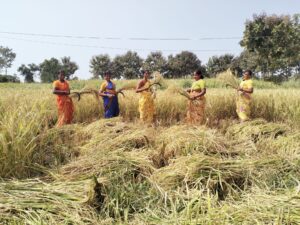For thousands of years, the indigenous tribes of the mountainous Cordillera region in the northern part of Luzon Island in the Philippines placed their fate in the hands of chosen women. They are the “seed keepers” and they are tasked with harvesting the life force of their rice.
Through the millennia of crop domestication and selection, the seed keepers were, and still are, instrumental in shaping the characteristics of their rice varieties. Only the most vigorous, acclimated, and healthy seedlings make the cut—which means they are the most suited to withstand pests, diseases, and the environmental conditions of the region. The enormous diversity of rice they developed in the Cordillera region is like a big box of genetic tools that serve as a crucial line of defense against the threat of insects and diseases.
But heirloom rice has intrinsic values to outsiders as well. The seed keepers were the original rice plant breeders. The enormous diversity of rice they developed in the Cordillera region is like a big box of genetic tools that serve as a crucial line of defense against the threat of insects and diseases.
“When we bring rice into the gene bank and make it available for breeding, the value in that comes in specific genes,” said Dr. Sackville Hamilton. “Maybe the aroma gene, maybe something special about the texture, the taste, the resistance to diseases, and many different attributes. We can generate a value that’s good for farmers out of the material in the gene bank, just by virtue of its genetic properties. We can combine these genetic properties into other varieties and make, we hope, better varieties.”
But these native rice varieties were not always viewed this way.
“When IRRI started, in the 1960s, the mentality was: we need more food,” Dr. Sackville Hamilton explained. “IRRI knows how to produce more food, higher yields, with more fertilizer, with dwarf genes, all those kinds of things. We developed the technology that replaced the technologies that farmers had at the time.”
But every community had its own culture, its own way of growing rice, and its own varieties. So, Dr. Sackville Hamilton said that by adopting IRRI’s early technologies, “We just threw away their old technology and replaced it with the new technology.”
The new technology included new high-performing rice varieties and vegetables. The Banaue terrace farmers in Ifugao Province, impressed by the new varieties, swapped their heirloom rice varieties for non indigenous, high-yielding rice varieties, which can be planted and harvested twice a year, and also for temperate vegetable crops promoted by the Philippine government through the Green Revolution.
The seed keepers watched helplessly as their children and grandchildren moved out and abandoned their ways. Their greatest fear was that heirloom rice would fade into oblivion as more people left the community. Over the years, much of the tribes’ expertise and wisdom have already disappeared. And, with further neglect, most of what was left could also be lost soon.
The answer to the seed keepers’ prayers came from two women who used their limited personal resources and passion for preserving heirloom rice cultivation. One of them, Mary Hensley, a Peace Corps volunteer in the Cordillera in the 1970s, was enamored of Tinawon and Unoy, two heirloom rice varieties possessing an intense aroma and flavors she could not forget.
Ms. Hensley teamed up with Vicky Garcia, founder and executive director of Revitalize Indigenous Cordilleran Entrepreneurs (RICE), and created the Heirloom Rice Project in 2004. This project provides organizational support to commercially produce and export heirloom rice without disregarding the people’s way of life.
Money from the export of heirloom rice is breathing life back into the languishing tribal communities by transforming them into thriving agricultural centers. Some of the people who left the region for jobs elsewhere are coming back, reuniting with their families, and renewing their covenant with their land. The health centers and schools they once dreamed of are now part of the landscape, according to Ms. Garcia.
In July 2010, three varieties of heirloom rice were included in the Ark of Taste, an international catalog of heritage foods in danger of extinction. All products listed in the Ark are recognized to have real economic viability and commercial potential.
Heirloom rice isn’t merely a link to the past anymore. It is now key to the Cordillera’s brighter future.









